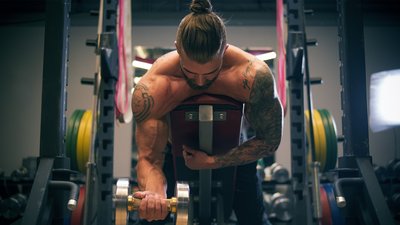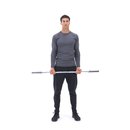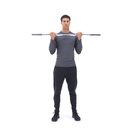OK, guys, what's the one muscle group you'd really love to add inches to? Arms, right? Few of us are satisfied with our biceps and triceps development, even though we faithfully curl, extend, and press until our arms feel like jelly. For what?
Yeah, maybe you've seen some growth after months or years of arm training, but probably not anywhere near as much as you had hoped for. I hate to be the one to break it to you, but if you haven't seen any gains in a long time, you won't get any bigger as long as you stick to your current routine.
That's the bad news.
The good news is that with some seriously hardcore "shock and awe"—with a workout that's more intense than anything you've ever done before—your arms will start budging that tape measure again.
Warning: If you're not ready for maximum effort and pain, the following workout may not be for you. But if you're determined to have bigger arms, right this way.
The Total Arm Wreckage Workout

BodyFit
$6.99/month- 2,500+ expert-created single workouts
- 3,500+ how-to exercise videos
- Detailed workout instruction
- Step-by-step workout tips
- Training at gym or at home
- Access to Workout Plans
- Access to Bodyfit App
- Store Discounts
Already have a Bodybuilding.com account with BodyFit? Sign In

What comes with BodyFit?

- Instructional Videos
Don't risk doing a workout improperly! Avoid injury and keep your form in check with in-depth instructional videos.

- How-to Images
View our enormous library of workout photos and see exactly how each exercise should be done before you give it a shot.

- Step-by-Step Instructions
Quickly read through our step-by-step directions to ensure you're doing each workout correctly the first time, every time.
Technique Tips
EZ-Bar Curl
While you're still fresh and have plenty of energy, kick off your workout by destroying your biceps with one brutal sequence. Set up three fixed-weight EZ-curl bars of increasing resistance, such as 20, 30, and 40 pounds, or maybe 30, 40, and 50 pounds. Unless you're incredibly strong, you probably won't need anything heavier. Keep in mind that the only rest you take here is to put one bar down and pick up the next one.
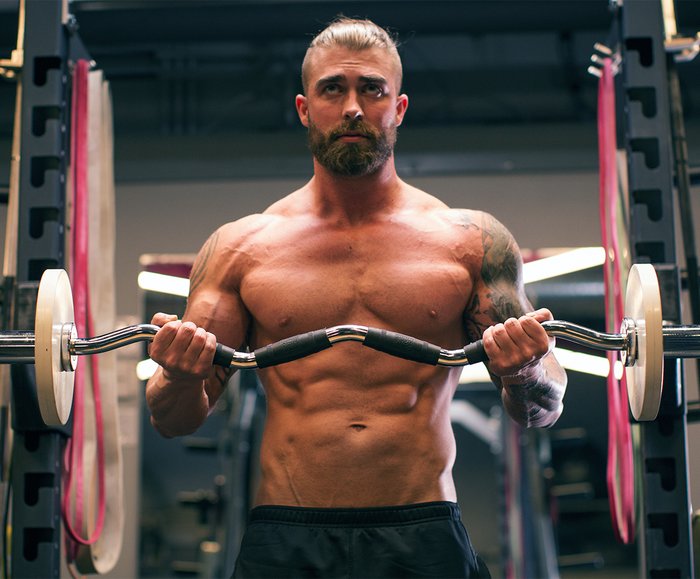
Do a total of 80 reps, first increasing the weight and decreasing the reps, then decreasing the weight and increasing the reps. Why so many reps? One reason many people fail to see arm gains past the initial beginning and intermediate phases is that they get caught up in using heavy weights for lower reps. As a result, they never get real pumps or place the muscles under tension long enough to stimulate significant muscle growth.
This biceps curl ladder forces you to achieve both. Don't worry if you don't complete all the reps listed. Do your best. You're going to do this sequence twice, with a 2-minute break in between to recover.
Triset: Reverse-Grip Triceps Push-down, Triceps Push-down, and Overhead Triceps Extension
By now, your biceps are probably so pumped that you can't straighten your arms. It's time to share the love with your triceps, which will also help stretch out your tight bis.
Set up a short straight bar attachment on a high pulley. Start off with 12 reps using an underhand grip. Flip your hands over for 12 more reps using a standard overhand grip. Finally, turn away from the pulley and weight stack and squeeze out 12 reps of overhead extensions.
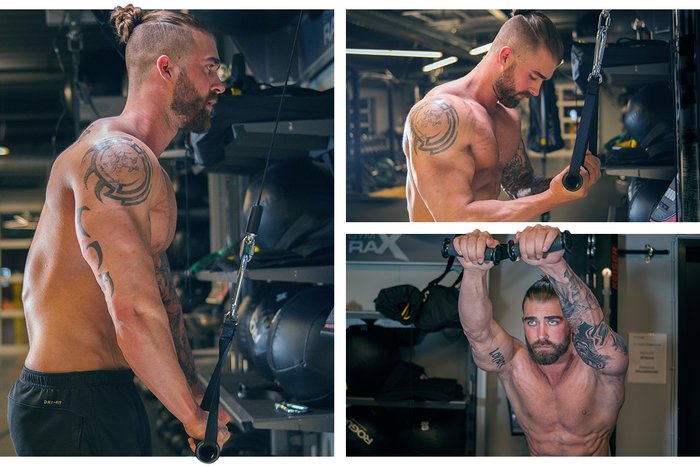
You may find you need to move the pin to a slightly heavier weight for the overhand portion of the triset, then back to the original weight again for the overhead section. Most of us are strongest when we use the standard overhand-grip position for push-downs.

Spider Curl
Your biceps had a breather there while you pumped up your triceps to skin-bursting tightness. Now it's time to turn your attention back to them with some curls.
Spider curls are typically done with an EZ-bar on the straight, vertical side of a preacher curl bench. This allows for a more complete range of motion than the sloped, padded side.
These will be, in effect, one-arm spider curls. Grab a dumbbell you can curl for about 8 reps and get to it. Once you reach positive failure, use your other hand to give yourself 3-4 forced reps. When you can't do any more without exerting maximum effort with your non-working arm, use that to lift your working arm into the top position.
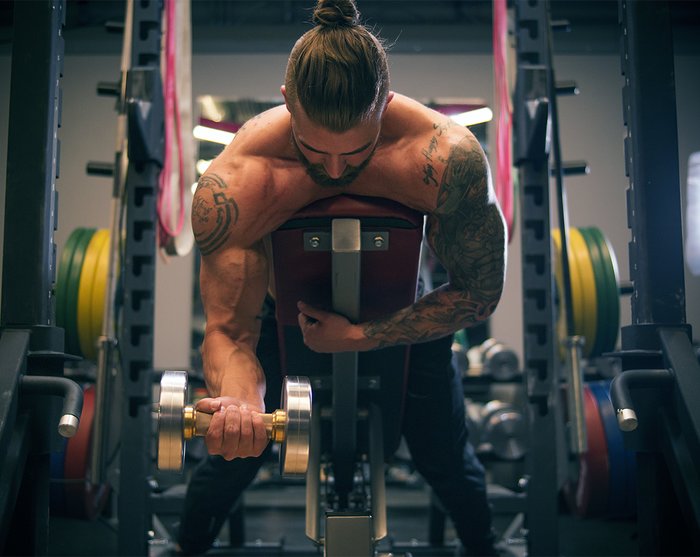
Slowly fight the negative as the dumbbell obeys the laws of gravity and pulls your working arm toward the ground. You should be able to get another 3-4 of these negative-only reps, at which point your biceps should be screaming.
Switch arms and give your other biceps the same beyond-failure punishment.
Weighted Bench Dip
Parallel dips are fantastic, but many trainers recruit too much of their chest and front delts when doing them. In contrast, bench dips do a far better job of targeting the triceps—especially when you're carrying some extra weight. See if you can do these dips with at least 25 pounds on your lap—if not with a 45-pound plate or two.

Start with enough weight on your lap to limit you to 10 reps, then remove the weight (a spotter can help here) and continue to failure with your body weight. You might be able to do another 10-20 unweighted reps.
Cable Hammer Curl with Rope Attachment
Now it's time to put the finishing touch on your biceps. These curls will target your outer, or long, biceps heads. The brachialis muscle between your long biceps head and the lateral head of your triceps will also put in some work.
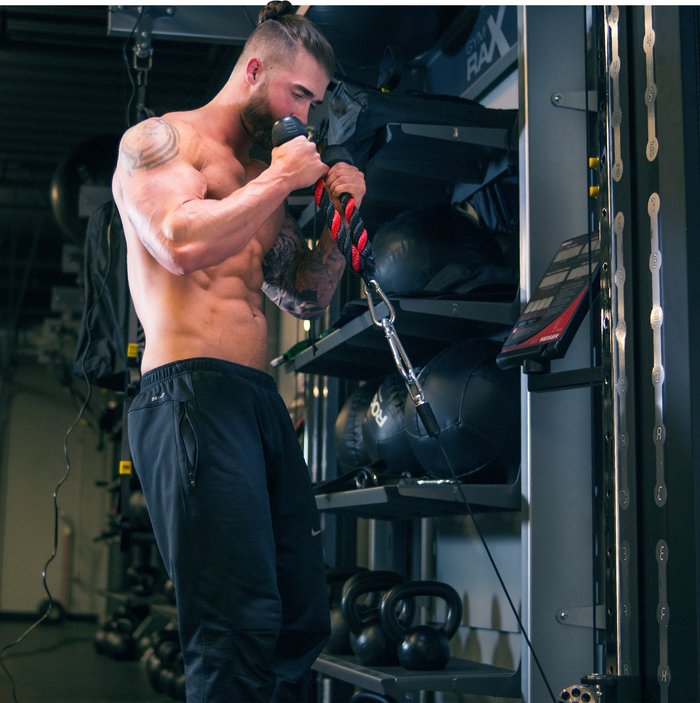
Clip a rope attachment to a low pulley. Holding the ropes together, curl up and squeeze your biceps. Lower it one-third of the way down and curl up again. That's one rep. Now you just need to do 35 more.
Superset: EZ-Bar Skullcrusher and Decline Barbell Bench Press
Skullcrushers are a supremely effective exercise, but they can be murder on your wrists and elbows. One way to make sure you don't injure yourself is to do them late in your routine, when your arms are so tired you won't be able to go very heavy.
Doing skullcrushers on a decline bench allows for a good range of motion and a good stretch at the bottom of the movement, while the EZ-bar will be kinder on your wrists than a straight bar.
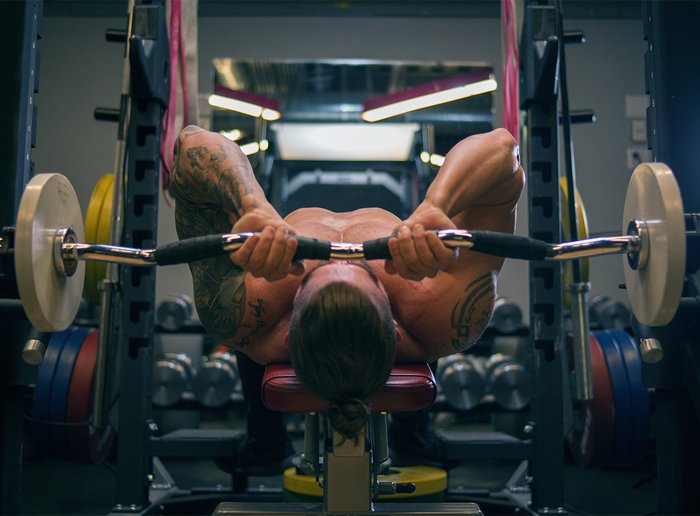
Do 12 skullcrusher reps, lowering the bar to just above your hairline and keeping your forearms perpendicular to the ground. Then, switch to decline barbell bench presses, using a close grip, to pump out 12 more reps.
If you find that the weight is too light to challenge you on the presses, have a spotter or training partner swap out the bar for a heavier one. If that weight is too heavy for the skullcrushers, do them close to a Smith machine. When you finish the skullcrushers, jump over to the Smith machine loaded with more weight and do your 12 decline barbell bench presses.
Why Alternate Biceps and Triceps Movements?
There are a few reasons why it makes sense to alternate between these two muscle groups. First, switching between them allows one group to recover while the other one is working. This technique also ensures that each group gets equally intense work. If you did all the biceps or triceps movements first, the other muscle group would suffer from being trained later when you're more fatigued.
Finally, working opposing muscle groups gets a better pump, as many of the old-school bodybuilders discovered long ago. Blood floods and stretches one group while the other group contracts. It's what four-time Mr. Olympia Jay Cutler used to refer to as "stretch and fill."
How to Structure Your Arm Training
To provide your arms with the best chance to grow, consolidate your other muscle groups into a few workouts so you have time to give your arms their own training day. For a period of 6-8 weeks, follow a split like this:
- Day 1: Arms
- Day 2: Legs
- Day 3: Chest and Shoulders
- Day 4: Back
- Day 5: Rest
With this schedule, you'll train arms every sixth day, after a full day of rest. Every time you have arm day, you can hit it hard. Your biceps will also get indirect work on back day, as will your triceps when you hit chest- and shoulder-pressing movements.
If you can handle the intensity of this routine and keep yourself charged up with ample food and rest, you will finally see fresh new gains. Never mind the tape measure: You'll feel the growth every time you slip on a T-shirt and flex.


